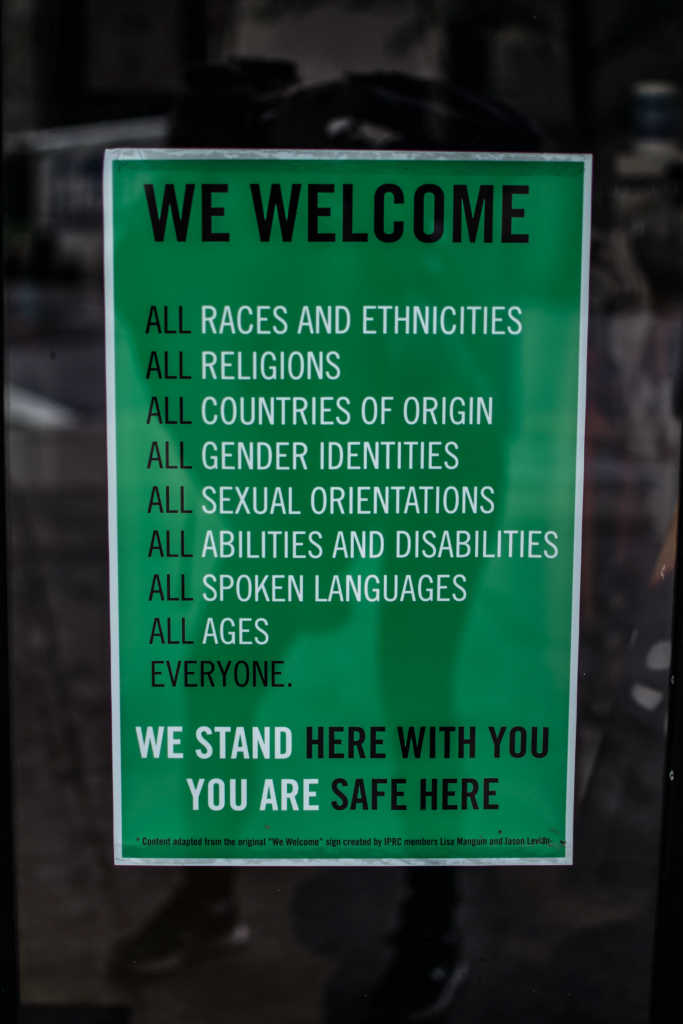Sam O’Brien, RingCentral UK | August 12, 2020
How to Foster an Environment of Equality in the Workplace
Equality and equity in the workplace is an important topic and one that many businesses are trying to tackle. We know that not only are equality and equity valued by employees but that they also benefit your business, too. Diverse companies are more profitable on average. Here are some ways you can foster an environment of equality and equity in your workplace.
Assess Your Hiring Processes
A great place to start is by assessing your hiring processes. Is there anything in your recruitment practices that makes it harder for some groups to join your organization – and thrive – compared to others?
Make sure your job advertisements are clear about your priorities. Don’t focus on aesthetics – things like ‘clean-shaven’ may seem innocuous, but it’s focused on a subset of the population and excludes others, such as religious groups who keep their facial hair. Avoid talking about a ‘culture’ fit (we’ll talk more about culture later) and instead, focus on your values. Your job descriptions and advertisements should explicitly include your commitment to diversity and inclusion.
Your HR department should be familiar with research into equality in hiring. For instance, research shows that women tend to only apply to jobs for which they fulfill all of the requirements (source), whilst men will apply when they meet only 60 percent of the qualifications. There are a variety of reasons as to why this is, but ultimately, there are proactive things you can do to reduce its impact. Mainly, only include criteria that are 100 percent necessary for the role.
Similarly, many job postings list physical requirements that are not actually requirements. Things like ‘must be able to stand for an entire shift’ and ‘must own a vehicle.’ These can exclude many who are differently-abled or those from lower socioeconomic brackets- so consider whether these are completely necessary, or if reasonable accommodations can be made.
Think about when to hire, e.g., do you expect someone to work shifts over an important religious holiday, and where your recruiting takes place. Do you expect people to travel for first interviews, or could that be done remotely? Particularly now, during the coronavirus, it’s best to make accommodations so you, your staff, and your job candidates can maintain safe physical distances while still having key conversations.
As well as removing vague and exclusionary language from your job listings, there are things that are important to focus on instead, such as your values, which we’ve already mentioned. Think about what benefits might sway disadvantaged groups to apply to you. Do you have a good parental leave policy? Can you provide childcare expenses? Are you open to managing a remote team? Do you offer continuous training programs? Highlight the positive aspects of the job that will deliver a diverse pool of job candidates.
Actively Retain Your Staff
Of course, it’s no good to hire a lot of diverse people if they’re not treated equally in the workplace. Make sure you have methods to assist in retention. Research shows that employees expect organizations to be socially responsible, and they choose their employer because its corporate values align with their own. Employee engagement activities such as workplace giving and volunteering are primary ways to invest in your workforce and improve your community — and significantly support your efforts to attract and retain talent.
Mentor/Sponsorship Programs
Pair new staff with more senior members who can proactively support them. Did you know that women of color who have sponsors are 81 percent more likely to be satisfied with their career progression than those without? Having an advocate willing to teach you the tricks of the trade, introduce you to networks, and support you within the role can go a long way towards increasing employee satisfaction.
This is particularly vital for disadvantaged groups, as they will often have had less access to these benefits before. For instance, a wealthy man who went to Yale will have had a lot of time to make those connections–that kind of networking is baked into their university experience. On the other hand, an equally skilled woman who grew up in poverty will not have had the same opportunities. By providing mentors, you can level the playing field and allow them to flourish.
Re-evaluate Culture
Many businesses pride themselves on having a certain work culture. However, this culture can sometimes be accidentally exclusionary. This can be a particular problem when it comes to cross-team collaboration.
A common example of this is the emphasis on alcohol, e.g., after-work drinks, beer on tap in flexible workspaces, and alcohol-based rewards for performance. That’s not to say that these things are inherently bad, but promoting them as a key part of your business’ culture can put people off working for you – especially certain religious groups and others who don’t drink for various reasons. Having some alcohol-based events among many sober functions is great; having alcohol-only focused events is not advisable.
Other things that may seem neutral but can lead to an exclusionary culture include:
- Emphasis on working under pressure and having a thick skin
- Mention of working extra hours ‘when necessary,’ but no further clarification
- Work hard, play hard – especially when that ‘play’ is alcohol-focused
- The idea that working for your company is a privilege — something people are banging on your doors to do
- Explicit mention of ‘must have a sense of humor’
On their own, these aren’t necessarily bad things, but too often they relate to workplaces with discriminative culture. Here’s an example of a job posting taking these things further:
Many of these things are part of the company culture in places that overwork their employees (they’re very common in the gaming industry, which is notorious for ‘crunch,’ i.e., encouraging their employees to work 100 hours+ each week). People with priorities outside of work, such as those with children, those who care for loved ones, etc., will often find themselves unable to fully participate in companies with these practices. When it comes to humor, it’s often used to downplay insensitive or offensive comments, like in the job posting above.
By assessing your company’s culture, you can begin to build a more inclusive environment that people want to be a part of, rather than feeling excluded from.
Have Policies – and Stick To Them
No matter how good your hiring process is, and how much you work on your culture, you’ll probably still run into issues. Rather than sweeping them under the rug, show your commitment to equality in the workplace by acting accordingly.
It can be tempting to laugh something off as ‘oh, that’s just how they are’ – but that isn’t good enough. In order to foster equality, it’s important to hold everyone to the same standards, and that includes being penalized for being actively harmful or offensive. That’s not to say someone making an ignorant joke should be fired from a project, but that they shouldn’t get away scot-free either.
If you use applicant tracking software, try to avoid bending the rules for a particular individual (unless it’s making a reasonable accommodation, such as for a disability or something similar). Earlier, I talked about your hiring practices. It’s important that once they’re in place, you stick to them – otherwise they won’t work!
Provide Training
By providing on the job training, you open up opportunities to those with more varied backgrounds. This is great for fostering equality as it means all of your employees will be able to apply for higher roles or be promoted, as they’ll have the same skill sets. Whether that’s training them in HR digitalisation, leadership, or new software, make sure the opportunities are open to everyone. You should even get your management team to encourage those they think would benefit to apply for internal jobs.
It’s also worth providing active diversity training to everyone – but especially management and HR. Everyone has an unconscious bias that creeps into our decision-making, and diversity training can help all of us recognize and counteract that bias. It also means that if any of your employees come to you with issues, you’ll know how to help.
Update Your Work Environment
You might not think it, but even your location and environment can reduce inclusion. If your employees have the skills to work remotely, why not let them? Whilst some aspects of your business may rely on everyone being in a shared physical location, it’s worth critically assessing if they all do. Of course, that doesn’t mean you have to move to be entirely remote – but allowing employees to be flexible has many benefits. COVID-19 has certainly proven that many jobs–whether full- or part-time–can be done from a distance if given the appropriate technology and access.
If you do embrace remote working, you should be supplying the equipment and technology. Whether that’s a VoIP phone, computer monitor, desk chair, or meeting software, employees shouldn’t be out of pocket. This is particularly important now, with the increased financial hardships caused by the pandemic. You might worry about non-remote employees feeling penalized, but there are ways around this. You could supply a set amount as a stipend for ‘work expenses’ which would cover travel or home office equipment, or you could improve everyone’s set-up in the office at the same time.
Take the time to hire an accessibility consultant. Are there areas of your office that people with disabilities might not be able to access — and can you fix them? It’s not just about providing an appropriate bathroom; your entire office should be accessible for people with different abilities. Plus, it’s not just physical disabilities you need to consider. If you use call centre solutions in an open-plan office, people with ADHD or on the autism spectrum could feel overwhelmed. Do you have alternative spaces available? Do you have a prayer room, a breastfeeding space, and is your car park well lit? Inclusion by design plays a bigger role in equality than you may expect!
Keep Learning
One of the most important things you can do when working towards an environment of equality and equity is to keep learning. Progress is still being made, so when you are challenged and given suggestions on ways to improve, it behooves you to listen. It can be easy to become defensive, but by opening yourself up to constructive criticism–and new suggestions–you’ll be able to foster the diverse, equal environment you want.
About the author: Sam O’Brien is the Senior Website Optimisation & User Experience Manager for EMEA at RingCentral, a Global VoIP, video conferencing and call centre software provider. Sam has a passion for innovation and loves exploring ways to collaborate more with dispersed teams. He has written for websites such as G2 and Jotform. Connect with him on LinkedIn.
Cover image source

Get Resources and Insights Straight To Your Inbox
Explore More Articles
Workplace Fundraising + Volunteering Summit (April 2nd and 3rd, 2025)
Join us in attending this virtual summit! The America’s Charities team is joining up with other leading voices in the workplace giving space for a…
Read ArticleThe Time to Act is Now
The results of the 2024 National Assessment of Educational Progress (NAEP) are in, and the findings are, in a word, heartbreaking. This assessment serves as…
Read ArticleOpen Position: Non-Profit Account Manager, Employee Assistance Funds & Scholarships (Remote – Full Time)
We are professional, agile, customer-centric and our goal is to inspire employees and organizations to support causes they care about. We help nonprofits fundraise unrestricted,…
Read ArticleGet Resources and Insights Straight To Your Inbox
Receive our monthly/bi-monthly newsletter filled with information about causes, nonprofit impact, and topics important for corporate social responsibility and employee engagement professionals, including disaster response, workplace giving, matching gifts, employee assistance funds, volunteering, scholarship award program management, grantmaking, and other philanthropic initiatives.








